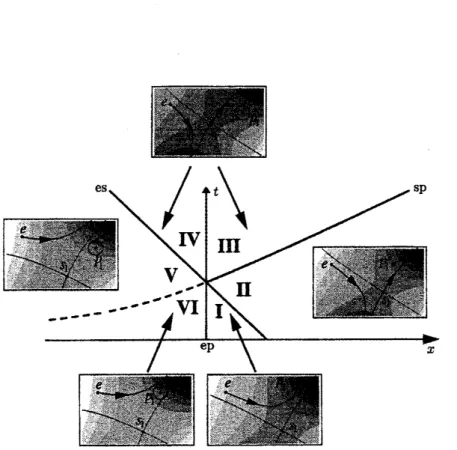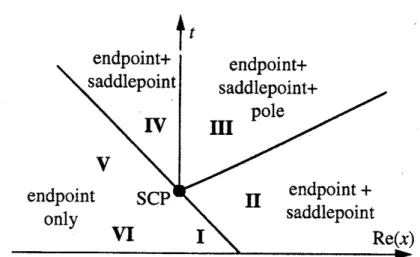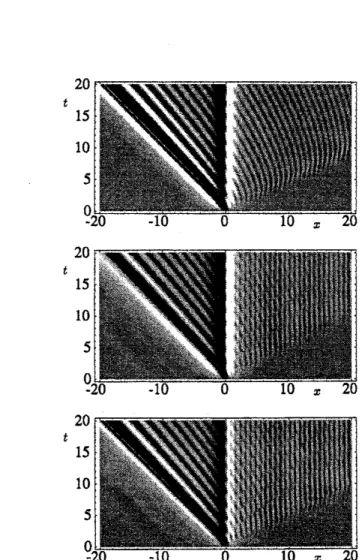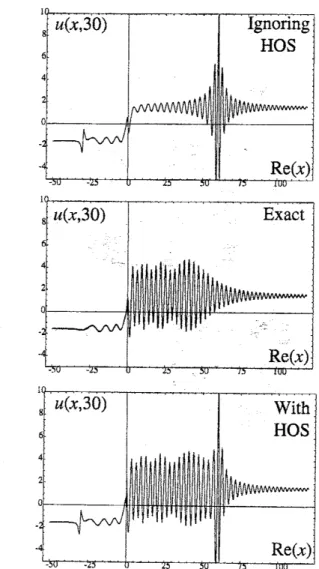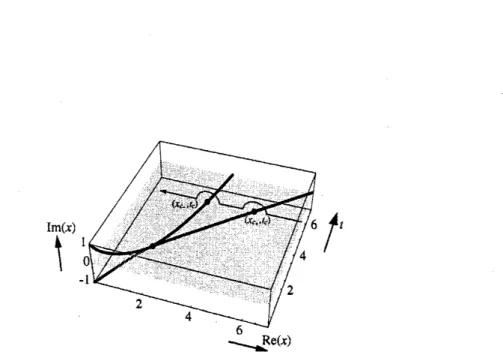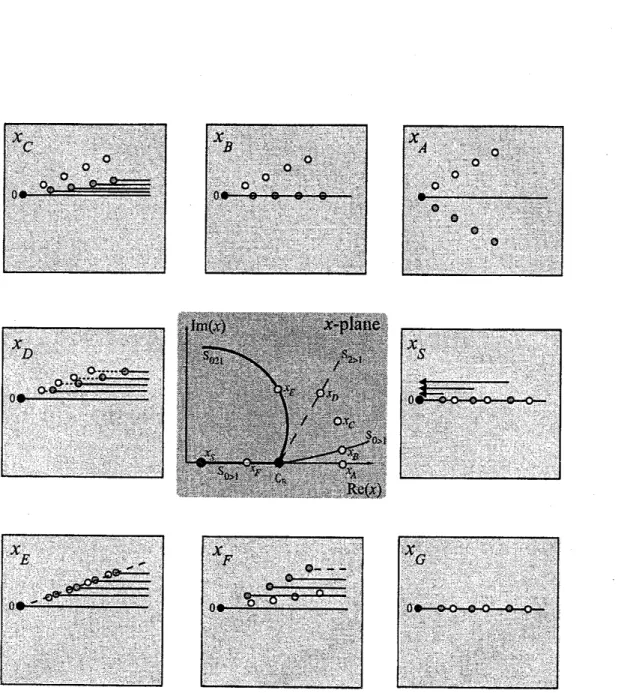C.J.Howls
University ofSouthampton
November 30,
2004
1
Introduction
Rom all the examples of theactivity ofStokeslines in the previoustwo papers Howts (2005ab),
the reader may be left with the impression that the higher order Stokes phenomenon is an
analyticalrelic whose influence isconfined to the complex plane. Inthis paper wedem onstrate
that thisisfar fromtrue,and that thehigherorder Stokesphenomenoncanresult in farreaching
effects in real space.
Here we shallstudytwo pedagogical examples. The firstis alinearpartial differentialequation
similar tothat ofthe second paper Howls (2005b). Hereweshall show that the activity ofStokes
lineshasboth aqualitative and quantitative effect onthe largetimebehaviour ofthesolution.
The second examples is Burgers equation. Although an integrable nonlinear PDEwe study it
because ofits canonical rolein the discussionofsmoothed shockwave form ation. We shall see
that when viewed from an asymptotic problem, thehigher order Stokes phenomenon iscrucial
to the mechanism for theformation of the shock.
2
Example: Linear Partial
Differential
Equation
We study the effect of the higher order Stokes phenomenonon the large time behaviour ofthe
partialdifferential system $-\infty<x<+\infty,$ $t>0$,
$u_{t}-u_{x}= \epsilon^{2}u_{\sigma ixx}-\frac{1}{1+x^{2}}$, $u(x, \mathrm{O})=\arctan x$, (2. 1)
where $u_{x},$ $u_{xx},$ $u_{xxx}arrow 0$ as $|x|arrow$ oo and $0<\epsilon<<1$
.
This system is intimately related to theHowls et at (2004). However here, for ease, we shall use an integral approach to $\mathrm{i}1^{1}[perp] \mathrm{u}\mathrm{s}\mathrm{t}\mathrm{r}\mathrm{a}\mathrm{t}\mathrm{e}$
the
how thehigherorder Stokesphenomenonaffects theremainderterms andexpansionsin different
regions of the real a$=(x, t)$ plane.
The systemcan be solvedexactly by Fourier transformsas asumofintegrals
$u(x, t; \epsilon)=\arctan x+\sum_{j=1}^{2}I_{j}(x, t;\epsilon)+\sum_{j=3}^{4}I_{j}(x;\epsilon)$, (2.2)
where
$I_{1}(x, t; \epsilon)=\oint_{0}^{\infty}\frac{\mathrm{i}p/2}{p^{2}-1}e^{-f(p;x,t)/\epsilon}dp=I_{2}^{*}(x,t;\epsilon)$ , (2.3)
$I_{3}(_{X\mathrm{i}} \epsilon)=\oint_{0}^{\infty}\frac{\mathrm{i}p/2}{1-p^{2}}e^{-p(1+ix)/\epsilon}dp=I_{4}^{*}(x;\epsilon)$ , (2.4)
and
$f(p;x, t)=p(1+\mathrm{i}x)+\mathrm{i}p(1-p^{2})t$, (2.5)
The star denotes complex conjugation. In $I_{1}$ and
I3
(respectivelyI2
and $I_{4}$) the contours areindented around thepolesat$p=+1$inprescribedmannersuchthat there is(initially)nooverail
pole contribution andthe initial conditions
are
satisfied as $|x|arrow\infty$For$t>0$, asymptoticcontributionsto $I_{1}$ and $I_{2}$ canarise from the endpointsat$p=0$, thepole
at$p=+1$, and oneoftwo saddlepoints. For$I_{3}$ and I4, analogous contributions
can
onlyarisefrom theendpoint and thepole at$p=+1$
.
To studythe time evolutionm of the problemin the real $(x, t)$ plane, without loss ofgenerality
we
can
restrict our attentionto $I_{1}$.The endpoint at $p=0$, isdenoted by thesuperscript/subscripts $e$; the pole $\mathrm{a}\mathrm{t} +1$ by
$p_{1}$, at $- 1$
by$p_{2}$; the saddies at
$p=\pm\sqrt{\frac{1}{3it}(1+\mathrm{i}(x+t))}$ (2.6)
by $s_{1}$ (for $+$) and 82 (for $-$). The choice of notation is now seen to agree with the labelling
ofcontributions inthe second paper (Howls 2005b) allowingfor the additional terms that arise
from the sumof complex conjugates.
As weusethe integralrepresentationsit isquiteeasyto
see
nowthat theasymptoticbehavioursare given by:
$e^{-f\mathrm{j}/\epsilon}T^{(g)}(\epsilon)$ (2.7)
where$j$denotes $e,$$s_{1}$ or$p_{1}$, with the following expressions
Figure 1: The sixregionsin the real$(x, t>0)$half-planeinwhich differentasymptoticbehaviours
for$I_{1}$
are
possible. TheseregionsaredeliniatedbyStokes lines. The notation “es”,forexample,referstoanendpoint switching
on a
saddle contribution. The dashedStokeslinebetween$\mathrm{V}$ andVI is active, but irrelevant. The dotted line between regions III andIV is an inactive Stokes
line.
$f_{s_{1}}(x, t)= \frac{2\mathrm{i}(x+t-\mathrm{i})^{3/2}}{3\sqrt{3t}}$, $T^{(\epsilon_{1})}(\epsilon;x,$$\mathrm{A}\sim\sum_{r=0}^{\infty}T_{r}^{(e_{1})}\epsilon^{r+1/2}$, (2.9)
$f_{\mathrm{P}1}(x, t)=1+\mathrm{i}x$, $T^{(\mathrm{p}_{1})}( \epsilon;x, t)=-\frac{1}{2}\pi$
.
(2.10)The first coefficient of the saddlepointexpansion about $s_{1}$ is
$T_{0}^{(s_{1})}= \frac{1}{2}\mathrm{i}\sqrt{\pi i}\frac{(3t)^{1/4}(x+t-\mathrm{i})^{1/4}}{x-2t-\mathrm{i}}$
.
(2.11)It is important tonote that contributions from thesaddle and endpoint
are
both (asymptotic)infinite series. The single term contribution from the pole is exact.
Theconjugacyof$I_{2}$ and$I_{1}$
mean
thattheyhave analytically similar structures and the relevantexpansions
are
just the correspondingconjugates of (4.8). The contributions bom integral $I_{3}$can
be obtained by setting $t=0$ in (2.9) and (2.10), and multiplying the results by-l. Thecorresponding expansions for
I4
are
the conjugates of those fromI3.
With all the above contributions it isastraightforward task to draw the candidate Stokes
curves
There arethree candidatesfor Stokes
curves:
.
the line$x=0$where$F_{ep1}(x, t)\equiv f_{\mathrm{P}1}-f_{e}=1+\mathrm{i}x>0$ (2.12)
the endpoint may switch on
a
pole (residue) contribution;.
along acurverunningforward in time from negative $x$ to positive $x$where$F_{\mathrm{s}_{1}p_{1}}(x, t)\equiv$ $f_{p1}-f_{s_{\mathrm{I}}}=1+ \mathrm{i}x-2\mathrm{i}\frac{(x+t-\mathrm{i})^{3/2}}{3\sqrt{3t}}>0$ (2.13)
asaddle may switchon apole contribution;
.
alongthe line $x\mathrm{B}$$=1/\sqrt{3}$runningforward in time where$F_{es_{1}}(x, t) \equiv f_{s_{1}}-f_{e}=2\mathrm{i}.\frac{(x+t-\mathrm{i})^{3/2}}{\mathrm{q}\sqrt{3t}}>0$, (2.14)
theendpoint may switch on a saddle.
Ananalysisofasequenceofplots of thesteepest descent contours as afunction of$x$ and$t$Jeads
to the findingsof figure 2. Theendpoint $e$contributes for all values of$x$ and $t$.
In region $\mathrm{I}$, only the endpoint
term contributes. Across the Stokes line between regions I
and $\mathrm{I}\mathrm{I}$, the dom inant endpoint switches on
a subdominant contribution from $s_{1}$. Across the
Stokescurvebetweenregions IIandIII, $s_{1}$ switcheson a (reiatively) subdominant contribution
from $p_{1}$ (which in turn is sub-subdominant to the contribution from $e$. Crossing $x=0$ from
region Iclockwise into region$\mathrm{V}\mathrm{I},$ $e$switcheson asubdominantpolecontribution from
$p_{1}$
.
Thiscombination persists across the apparent Stokes line between $s_{1}$, pi and into region $\mathrm{V}$, since
there is no $s_{1}$ yet present to switch $\mathrm{o}\mathrm{n}/0\mathrm{f}\mathrm{f}$
a
contribution from$p_{1}$. Across the line between$\mathrm{V}$
arrd $\mathrm{I}\mathrm{V},$ $s_{1}$ is finally switchedon by $e$
.
Thus thereare contributions from $e,$ $s_{1}$ and $p_{1}$ inbothregions III and$\mathrm{I}\mathrm{V}$.
From (2.12) the axis along$x=0,$ $t>1/\sqrt{3}$ delineating regions III and IV should bea Stokes
curve where a dominant $e$ switches on or off a subdominant contribution from
$p_{1}$
.
However,the presence ofsuch aStokes curve would lead to a contradiction. For example, by continuing
from region III anti-clockwise to IV, $e$ should then switch off
$p_{1}$ so that no contribution from $p_{1}$ existed in $\mathrm{I}\mathrm{V}$. To the contrary,
the clockwise continuation around $t=1/\sqrt{3}$ from region I
suggests that IV should indeed contain
a
$p_{1}$ contribution. The conclusion is that despite thepresence ofthe necessary dominant and subdominant terms, no Stokes phenomenon can take
place. This is confirmed bya steepest descent analysis (seeinsets in figure 1).
Thispictureisentirely consistentwith the Stokescurvegeometryplotted for areal$\mathrm{t}$-sectionin
Figure 2: The Stokes curves (solid lines) and the higher order Stokes
curve
(bold line) for $I_{1}$(centre pane) compared with real sections complex $x$-planes (left and right panes) at times
$t=t_{1}=1/\sqrt{3}$ (dotted line in middle pane) and $t=t_{2}>1/\sqrt{3}$ (dashed line in middle pane).
Only the active and relevant Stokes
curves
have been drawn. The kidney-shaped higher orderStokes
curve
growsinsizefrom$t=0^{+}$ andfirst intersectsreal $(x, t)$space at $t=t_{1}=1/\sqrt{3}$, theminimum of the higher order Stokes
curve
in real $(x, t)$ space. Thereafter the Stokes curve $S_{ep}$isinactive. The points$\alpha,$$\beta,$$\gamma,$$\delta$indicate the intersections of the Stokes andhigher order Stokes
curvesat $t_{2}$ (right pane) with the real$(x, t)$ plane (centrepane).
Stokes line in the complex $x$-plane does not intersect the real $(x, t)$ plane. The Stakes curve
$S_{e>\mathrm{p}}$ is active for $\Im(x)$ below the SCP but inactive above the higher order Stokes
curve.
As $t$ evolves between $0^{+}$ and $1/\sqrt{3}$ theintersection of the active $S_{e>p}$ curve traces out the activeStokesline delineatingregions I and$\mathrm{V}\mathrm{I}$. At $t=1/\sqrt{3}$the SCP intersects with real $(x, t)$ plane
at $(0, 1/\sqrt{3})$ and switches offthe
curve
delineating regions IIIand$\mathrm{I}\mathrm{V}$. The curves delineatingIIandIII, IV and$\mathrm{V}$ respectively,arestill active. The locus of the points of intersection ofthe
higherorder Stokes
curve
inthe complex$x$-plane andthe real $(x, t)$planeisthe $U$-shapedcurve
defined by
$\frac{F_{es_{1}}}{F_{\mathit{3}1\mathrm{P}1}}>0$, (2.15)
that
runs
between infinities inregionsIIand$\mathrm{V}$, through thepoint $(x, t)=(0,1/\sqrt{3})$,seefigure2.
In figure3 wedisplaytheoverall combination of termsthatcontribute from the
sum
of the fourintegrais. For theintegrals $I_{3}(x;\epsilon)$ andI4(x;$\epsilon$) a singleStokes line existsalongthe wholeof the
$t$-axis. Superposing thisonthe integrals $I_{1}(x,t;\epsilon)$ andI2(x,$t;\epsilon$)
we
find that the compositeex-pansionhasa Stokes linealongthe$t$-axisfor$t>1/\sqrt{3}$, butnot for$t<1/\sqrt{3}$
.
This does not alterthe role of thehigher order Stokes phenomenon, which has determined the constituent Stokes
behaviour of$I_{1}(x, t;\epsilon)$ and$I_{2}(x, t;\epsilon)$. Hence, in regions$\mathrm{I}$, VIand$\mathrm{V}$ only the endpointsofthe
four integralscontributes to the asymptotics, InregionII and IV there
are
also contributionsFigure 3: The active and relevant Stokes lines together with the asymptotic contributions in
each region for thecomplete expansion of(2.1) generated bysumofintegrals in (2.2).
A furthersignificantconsequence of this example isthenecessity to includeexponentially sub
subdominant terms in the largetime asymptotic analysis. For $x>0,$$t\approx \mathrm{O}$, the dominance of
the asymptoticcontributions is (cf. (2.12),(2.13),(2.14))
$|e^{-f/\epsilon}eT^{(e)}|>|e^{-f/\epsilon}s_{1}T^{(s_{1})}|>|e^{-f/\epsilon}\mathrm{p}_{1}T^{(p_{1})}|$
.
(2.16)The longer time behaviour inregion III involves all three such contributions, with $e^{-f_{B}/\epsilon}1T^{\{s_{1})}$
a decaying function of time but $e^{-f\mathrm{p}_{1}}/\epsilon T^{\langle p_{1})}$
independent of time. Consequently $e^{-f_{\mathrm{p}_{1}}/\epsilon}T^{(p_{1})}$
develops
as
the principletimeindependent oscillatory background to the montonic $e^{-f/\epsilon}eT^{(e)}$.
If the sub-subdominant $e^{-h_{1}/\epsilon}T^{(\mathrm{p}_{1}\rangle}$
had been initially neglected as irrelevant near to $t=0$,
then anincorrect large $t$, finite-x behaviourwould have beenpredicted.
This
can
beverified bycarrying out
a
similar analysisfor the other integrals $I_{2},$ $I_{3}$,I4
and combining the results.In figure 4 we display a comparison ofa numerical evaluation ofthesum ofthe four integrals
in (2.2) in the real $($$,$t)$-plane against the leading order behaviours ofthe asymptotics within
each Stokes regionfor the $\epsilon=$ 0.125. The plot in the middle of figure 4 is the
sum
ofthe four
integrals, evaluatednumerically. The brightnessindicates the height. Theplot at the bottom of
figure4is the result of taking justtheleadingorder behaviours ofallasymptotic contributions
in each region as detailed in figure3.
In figure 5 wetake
a
section for$t=30,$ $\epsilon=0.5$and plot the spatialdependence ofsolutions and
approxim ations. Theplotat the top is theleadingorderasymptotic approximationthat started at $t=0^{+}$ by ignoring the initially subsubdominant $e^{-fp_{1}}/\epsilon T^{(p_{1})}$
.
The middleplot is the exact
solution. The bottomplot is the leading orderasymptotic evolved according to the activity of
Stokes lines.
Figure 4: The plot in the middle is the solution of the PDE (2.1) minus $\arctan x$ with $\epsilon=$
0.125. The plot at the bottom is the resultof taking leadingorder behaviours of all asymptotic
contributions in each region (seefigure3), andthe plotat the top is the same, except that the
contributions from the sub-subdominant poles is omitted.
asym ptotics arising froma neglect of the sub-subdominant pole (top plots) ishowever at odds
with the exact result in region III. The exact
wave
structure is dominated at larger timesin this region by the initially sub subdominant pole contribution A neglect of this would have
resulted in
a
false conclusion being drawnas
to the largetime behaviour. Finaliy only in theneighbourhoods of the active Stokes
curves
do we observe that the sum of the leading orderbehaviours changes discontinuously,
This example clearly demonstrates that the real time evolution of the solution of
even
linearPDEsmay be affectedby the change in activity of Stokes
curves
caused byhigherorder StokesFigure 5: Theplot inthemiddle isthe exact solution of the PDE (2.1) at$t=30$ obtained from
quadraturewith$\epsilon=0.5$
.
Theplot at thebottomisthe result of taking leading orderbehaviours
of all asymptotic contributions in each region andthe plot at the top is thesame, except that
the contributions from the
sub-subdominant
poles is omitted. The disagreement between theexact and asymptotic approximations
near
to$t=-30$ and $t=60$isdue to the proximity of theturning points TP in the complexplane at $x=2t+\mathrm{i}$ and $x=\mathrm{i}-t$ which
cause
the leadingorders to be the smallest term in the expansion,i.e., aman-uniformasymptoticanalysisbecomes
recent literature see for$\mathrm{n}$ example (but not exclusively), Costin
&
Costin (2001), Costin&
Kohut (2004), Costin
&
Tanveer (2004), Olde Daalhuis $(2004\mathrm{a}\mathrm{b})$.
We provideanoverview ofthe workhere, asthedetails willappearelsewhere Howls et$al$(2005).
Westart with the Burgers equation
$u_{t}+uu_{x}=\epsilon u_{xx}$, (3.1)
where
$x\in C$, $t\geq 0$, $\epsilonarrow 0^{+}$, (3.2)
and chooseinitial Cauchyconditions
$u(x, 0)= \frac{1}{1+x^{2}}$, and $uarrow \mathrm{O}$ as $|x|arrow\infty$. (3.3)
Obviously, Burgers equationmaybesolvedusing theCole-Hopfintegral representation,orusing
approximate matching techniquesto locate theposition of the smoothed shockthatform $\mathrm{s}$after
afinite time. Howeverwe shall approachthis pedagogicalexamplefroman exponential
asymp-totics pointof view toprovidean alternative, novel,view ofthe smoothed shock formation.
The small $\epsilon>0$ expansion of thesolution
can
be deduced tohave atemplate of the form$u(x, t; \epsilon)\sim u^{(0)}(x, t;\epsilon)+\sum_{n=1}^{\infty}C_{1}^{n}u^{\langle n,1)}(x, t;\epsilon)+\sum_{n=1}^{\infty}C_{2}^{n}u^{(n,2)}(x, t;\epsilon)$ (3.4)
where
$u^{(0)}(x, t;\epsilon)$ $\sim$ $\sum a_{r}$$x\infty$( ,th)$\epsilon^{r}$ (3.5) $\tau=0$
$u^{(n,j)}(x,t;\epsilon)$ $e^{-nj_{j}(x,t)/\epsilon} \sum_{r=0}^{\infty}a_{r}^{(n_{I}}’)(x, t)\epsilon^{r}$, $j=1,2$, $n=1,2,3,$$\cdots$
.
(3.6)By substitution into (3.1) we seethat $a\mathrm{o}(x, t)$ satisfies theinviscid Burgersequation
$\frac{\partial a_{0}}{\partial t}$
and for$r\geq 1$ the $a_{r}(x, t)$satisfy
$\frac{\partial a_{r}}{\partial t}+\sum_{\epsilon=0}^{r}a_{r-s}\frac{\partial a_{s}}{\partial x}=\frac{\partial^{2}a_{r-1}}{\partial x^{2}}$, $a_{r}(x_{r}0)=0$
.
(3.8)The leading orders of the largest of the subdominantexponentialcontributionssatisfy$\emptyset(e^{-nf/\epsilon})$
generates
$\frac{\partial a_{0}^{(1\mathrm{j})}}{\partial t}+(a_{0}+2f_{x})\frac{\partial a_{0}^{(1,j)}}{\partial x}+(\frac{\partial a_{0}}{\partial x}-a_{1}f_{x}+f_{xx})a_{0}^{(1,j)}=0$,
(3.9)
Theexponentialfunctions $fj(x, t)$ satisfythe first order nonlnear equation
$f_{t}+a_{0}f_{x}+f_{x}^{2}=0$. (3.10)
The boundary data for these functionscanbefound byconsiderationofthe rays of (3.7).
Therearethreeraysof (3.7) through each point $(x, t)$
.
Theseare
the lines$x=xj+a\mathrm{o}(xj)t$, $j=0,1,2$, (3.11)
where here and henceforth,
we
have abbreviated $a_{0}(x_{j}, 0)$ to $a_{0}(x_{j})$ and the $x_{\mathrm{J}}$are
theinter-section pointsofthese rays with the complex plane $t=0$, oralternatively, the locations of the
saddlepoints in the Cole Hopf solution. On these raysthe$a_{0}$ take the constant values
$a_{0}(x_{\mathrm{J}})= \frac{1}{1+x_{j}^{2}’}$ $j=0,1,2$
.
(3.12)Theroot $x\mathit{0}$of (3.11) is chosen to be the
one
that is real for all real $(x, t)$.
Thefamilies of rays
generated by the$x_{j}$ are tangential at caustics which simultaneouslysatisfy (3.11) and
$0=1+ \frac{da_{0}(x_{j})}{dx_{j}}t$, $j=0,1,2$, (3.13)
For thechosen initial conditions the causticsaregiven by
$t= \frac{2}{27}(x(x^{2}+9)\pm(x^{2}-3)^{3/2})$. (3.14)
Since we restrict ourselves to$t>0$ the caustics
are
one-dimensionalcurves.
Thereare two realand twocomplex caustics in the $(x,t)$ space under consideration,
see
figure 6. Onthe complexcaustic with $\Im x>0$, roots $x_{0}$ and$x_{1}$ coalesce and
so we
call this caustic $c_{01}$.
On thecomplexcaustics with $\Im x<0_{\}}x_{0}$ and$x_{2}$ coalesce and is thus labelled $C_{02}$
.
Onthe real caustics $c_{R},$ $x_{1}$and$x_{2}$ coalesce.
These caustics$c_{R}$ separate the regions in the real $(x,t)$
plane in which the classical smoothed
shock of Burgers’ equationforms (‘inside’ thecaustic) from regions where theamplitude
or
theFigure 6: Caustics in complex $x$-space for real $t$ and
a
path of analytic continuation aroundthem.
Figure 7: Rays and caustics for Burgers’ equationwith initial data (3.3) for$x,$$t\geq 0$
.
The realAs$x_{1}$ and$x_{2}$ arecomplexoutside$C_{R}$, impositionof realityonthesolution is sufficienttoensure
uniqueness ofthe solution in the real $(x, t)$ planeoutside thereal caustics. The uniquesolution
to theinviscid Burgers’ equationoutside the caustic in the real $(x, t)$planeisthus $a_{0}(x_{0}(x, t))$
.
It isobvious, andwellknown, thatinside $C_{\mathcal{R}}$,the multivalued leadingorder invisicid behaviour
$ao(x, t)$ that satisfies the inviscid Burgers’ equation cannot adequatelyrepresent thesolutionof
viscid Burgers’ equation. By using exponentialasymptotics the effectofthemultivaluednessof
$a0(x, t)$ may becorrected.
Note thatthe$a_{0}$appearingin (3.10)isidentical to thechoiceof$a0$in the leading order behaviour
$u0$ in (3.5) . It istherefore $a_{0}(x_{0}(x, t))$, which iscompietely determined by (3.7), where$x_{0}(x$,?$)$
is the real solution of (3.11).
The exponents $f_{j}(x, t)$ must vanish on the complex caustics, since here they coalesce with the
exponentoftheleadingordersolution,i.e., $f_{0}(x, t)\equiv 0$,sothat the exponential correctionterms
arethere of thesame order
as
thefirstseries in (3.4). Thus theboundary data forthe solutionsof (3.10) are
$f_{j}(x, t)=0$ on $C_{0j}$, $j=1,2$
.
(3.15)and
$f1(x, t)=f_{2}(x, t)$ on $C_{R}$. (3.16)
Cole-Hopf, ordirect analysis of thePDE reveals that
$f_{j}(x(x0, xj),$$t(x0,xj))= \frac{1}{2}\int_{x_{0}}^{x_{j}}a_{0}(z)dz-\frac{1}{4}(a_{0}(x_{0})+a_{0}(x_{j}))(x_{j}-x_{0})$, (3. 17)
$j=1,2$
.
It can also be shown that
$a_{0}^{(1,1)}(x_{0}, x_{1})=(a_{0}(x_{1})-a_{0}(x_{0}))\sqrt{\frac{a_{0}(x_{1})-a_{0}(x_{0})-a_{0}’(x_{0})(x_{1}-x_{0})}{a_{0}(x_{1})-a_{0}(x_{0})-a_{0}’(x_{1})(x_{1}-x_{0})}}$. (3.18)
This resultsholdsfor all values of$x0$ and$x_{1}$
.
We
now
turn tothe singularitystructureinthe Borelplane. It is actuallyalotmorecomplicatedthan weshall outlinehere (seeHowls et
at
2005). However forthepurposes of this paper it willsuffice to consider thefollowing simplified story.
The location of singularities visible from $\tau=f_{0}(x, t)$ are indicated in figure 8 for
a
typicalvalue of$(x, t)$. Rom(3) wededuce thatin the Borelplane, (logarithmic) branch-points exist at
$\tau=nfj,$ $j=1,2,$ $n=1,2,3,$$\cdots.$ Adetailed analysis of thetransseries (see e.g., Olde Daalhuis
$2004\mathrm{a}\mathrm{b})$ or the Cole-Hopf
rePresentation
shows that the Borel transform of$u^{(1,1)}(x, t;\tau)$must
see a branch-point at $\tau=f_{2}(x, t)$
.
Likewise the Borel transform of $u^{(1,2)}(x, t;\tau)$ must see adegenerate to a pair ofturning points. Due to symmetry of the initial conditions as $|x|arrow\infty$
we shall also initially just considerthe continuation around the turning point with the largest
values of$\Re x$. We label thispoint $x_{\mathrm{c}+}$
.
We take a path in the complex $x$-plane along the points $xA,$ $xB,$ $\cdots$, see figures 6, 8. This
complex path is taken to avoid any singular behaviour in the exponentially
sm
all transseries$u^{(n,1)}$ and$u^{(n,2)}$, ($u^{(0)}$ is actually regular at $C_{R}$), which neverthelesswillplay avital role inside
thecaustic region. It isobviously possible toobtainauniform asymptotic approximation
across
the caustic involving Airy functions. However we
are
interested here in the morefundamentalexponentialasymptoticbehaviour thatunderpins other procedures.
Surroundingthe centraldiagramof thecomplex$x$-planeinfigure8,aresnapshotsofthelocations
of the singularities as viewed from $\tau=f_{0}$ in the Borel plane at the positions $x_{A},$ $x_{B},$ $\cdots$
.
Aswe move aroundthe complex$x$-plane, the arraysofsingularities willpivot about $fo=0$.
We alsoplot thesections throughthe Stokes surfaces $S_{i>j}$
across
which contributions involving$f_{i}$ can switchon $f_{j}$
.
Note that at the turning point $x_{c+}f_{1}=f_{2}>0$, hence this turningpointdoes not directly involve$f_{0}$
.
Thus theStokes lines $S_{0>1}$ and$S_{0>2}$both passthroughtheturningpoint inertly and$f_{0}$ dominates $f_{1}$ and $f_{2}$ all along thisline in the vicinity of$x_{c+}$. On the other
hand theStokeslines$S_{1>2}$ and$S_{2>1}$ sprout at angles of$2\pi/3$from $x_{c+}$ (reflectingthe Airy-type
nature of the simple coalsecence). A higherorder curve $S_{021}$ exists for $(x,t)$ in the locality of
$x_{\mathrm{C}+}$ and is also showninfigure8. Note thata branchcutalsoemanatesfrom$x>x_{c+}$. However,
1n what followswe
can
avoid all interaction withit, andso for simpiicity wehave not includedit in the figure.
It transpires Howls et al (2005) that we only actually have to consider the Stokes lines $S_{0>1}$, $S_{0>2},$ $S_{1>2}$ and $S_{2>1}$.
We now start on the real $x$-axls outside the caustic regionwhere $x>x_{\mathrm{c}+}$
.
Wepick a generalpoint$x_{A}$, and aim to continue to$x<x_{c+}$in thecomplex$x$-plane. At$x_{A}$,tosatisfythedecayof$u$
as$|x|arrow$ oo(3.3), comparison ofthe fulltemplatefortheexpansion (3) reveals that$C_{1}=C_{2}=0$
.
Hence
we
have$u(x_{A},t\cdot, \epsilon)\sim u^{(0)}(xA,t;\epsilon)$, $(3,19)$
as thecomplete asymptotic expansion.
At $x_{B}$ we
cross
the Stokes line $S_{0>1}$. Here the array of singularities$nfi,$ $n=1,2,3,$Figure 8: The central panel depicts part ofthecomplex$x$-plane at constant $t>8/\sqrt{27}$for
ex-pansion (3.4) andillustrates thelocation of Stokesand higher order Stokes
curves.
Surrounding the central panelare
snapshots of the distribution of singularities in the Borel plane,as seen
from $f_{0}$, at the various values of$x$ indicated. See the main text for
a
fulldescription of what
a Stakes We canshow (either fiiom Cole-Hopfordirectlyfrom the PDE
that $K_{01}=1$
.
At $x_{D}$ weencounter the Stokes lne$S_{2>1}$. At thispoint singularity $f_{1}-f_{2}>0$andsothereisa
potentialfor aStakesphenomenonto takeplace. However, singularity $f_{2}$ isnot contributingto
the transseriesexpansion of the functionwe
are
interested inat$x_{D}$. Henceno
Stokesphenomenonbetween$f_{2}$ and$f_{1}$ actually takesplace andthis is againanirrelevant Stokescurve,
At$xE$,weencounterthe higherorder Stokesline$S_{021}$. Onthiscurvethe Borelsingularities$f_{0},$ $f_{1}$
and$f_{2}$ and all theirmultiplesarecollinear. Herewe seethatratherthan havingafinite number
ofcollinear singularities, we must deal with and infinite set, leading to an infinite number of
Riemannsheets.
As inlinear cases, since $|fi|>|f_{2}|$, on theline ofcollinearity in the Borelplanethe singularity
$f_{2}$ lies in between
$f_{0}$
and $f_{1}$. Whenwe crossthehigher order Stokesline, when viewed from$f_{0_{i}}$
thesingularity at
$f_{1}$
moves across acut from $f_{2}$ andonto adifferent Riemann sheet from
$f_{0}$
.
A more detailed analysisofall the othersingularitiesHowls et $al$ (2005) showsthat oncrossing
thehigherorderStokesline allthe singularitiesinthearray$f_{1},2f_{1},3f_{1},$ $\cdots$ move ontomutually
different Riemann sheets and
are
soare
directly invisible fromthe original expansion point $fo$,and thesingutarities$nf_{1}$ can
no
longer see$mf_{1},$ $m\neq n$.
At $xF$, the arraysare no-longer collinear with one another. However the $nf_{1}$
are
still collinearwith
$f_{0}$
: justbecause they might be on different Riemannsheets, this doesnot grant themthe
autono1nyto moveindependently.
At $x_{G}$, where $x$ is real, but $x<x_{c+},$
$f_{0}$
and the arrays $nf_{i}$,$mf_{2}$
are
all again colinear, thistime along the horizontal direction of Borelintegrationand $0<f_{i}<f_{2}$. A Stokesline therefore
potentially exists between
$f_{0}$
and the $nf_{1}$. However, since the $nf_{1}$ are
now
allon
differentRiemann sheetsfrom
$f_{0}$
, they
are
invisible to$f_{0}$
and cannot cross the actual Borel integration
contour, which is anchored at
$f_{0}$
but on the principal Riemann sheets. Thus the the Stokes
line$S_{0>1}$ is inactive and no Stokesphenomenonbetween $f_{0}$ andanyelement of
$nf_{1}$
takes place.
There is also the possibility of a Stokes phenomenonbetween $f_{0}$ and $nf_{2}$ or
even
$fi$ and $nf_{2}$,butthese are of lowerexponential order and will notconcern us here.
It isimportant
now
to recall that $\=x_{c+}$ isnot a turning point/caustic for0 and$nf_{1}$
.
HenceStokes curve that passesthrough$\=x_{c+}$.
We mowexamine the structureof the‘dominant’ part ofthe transseries on the real$x$-axlsinside
$c_{R}$
$u(x, t; \epsilon)=a0(x, t)+\sum_{n=1}^{\infty}K_{01}^{n}e^{-nf1(x,t)/\epsilon}a_{0}^{(n,1\}}(x, t)+O(\epsilon)$ , (3.21)
as $\epsilonarrow 0+$
.
Exponentially small terms are included before the 0$(\epsilon)$ in (3.21) because we arenow in a region where $fi(x, t)$ may decrease to zero. There is thus the possibility that these
exponentially small termscaninterferewith the $O(1)$ terms.
We combine (3.5), (3.6) and (3.10) and areable to deduce for $n=2,3,4,$$\cdots$, that
$a_{0}^{(n,1)}=(a_{0}^{(1,1)})^{n}(-2 \frac{\partial f_{1}}{\partial x})^{1-n}$ (3.22)
This simplerelationship allowsus to sum then-sum in thetransseries (3.21) and obtain
$u(x, t;\epsilon)=a0_{\backslash }^{(_{X}},$$t)+ \frac{2K_{01}a_{0}^{(1,1)}(x,t)^{\partial}\neq_{x}^{1}e^{-f_{1}/\epsilon}}{2\frac{\partial f_{1}}{\partial x}+K_{01}a_{0}^{(1,1)}(x,t)e^{-f\iota/\epsilon}}+O(\epsilon)$, (3.23)
as $\epsilonarrow \mathrm{O}+$. Thisresult isvalideverywhere in theregion where
$\Re f_{1}>0$and may beanalytically
continuedto the region where$\Re f_{1}\leq 0$.
If we continue along the iine $S_{0>1}$, in the negative $x$-direction the singularities $nf_{1}$ all move
towards $f_{0}$ in the Borel plane, see$x_{H}$. At the point $(x_{S}, t)$ the $nf_{1}$ appear to coalesce with $f_{0}$
.
This is the point at whichan exchange of dominance in the asymptoticexpansion stakes piace.
Classically,thisistheposition of thesmoothed shock, where the solutionchangesabruptly ffom
one valueto thenext.
Due to the coalescence of the exponents, from a naive point ofview, this point is apparently
a caustic/turning point of the asymptotics. Ifthis were a true turning point the derivatives
in individual terms in theasym ptotics would diverge at $x_{S}$
.
An examinationofthe coefficients$a_{r}(x, t)$(Howls et$al$2005)shows that this is not thecase. The
reason
for thisis that,
as
suggestedabove,atl thesingularities$nf_{1}$ and0 indeed do lie on mutttally
different
Riemann sheets: this isonly an apparentcoalescence. This is avirtualturning point.
We may now conclude with thefollowing keyobservations (further discussionmay be found in
Howls $al$2005).
The terms themselves in the transseries do not diverge at theposition of the smoothed shock
$xs$. This is because $xs$ is only
a
virtualturning point, since all the Borel singularities are onmutualiy different Riemannsheets, Hence the Borel singularities have accumulated to createa
Hence, when viewed from the standpoint of exponential asym ptotics, the higher order Stokes
phenomenon is an essential part of the mechanism for forming the smoothed (propagating)
shock.
The resummed transeries solution (3.23) is valid for values of$\<xs$
.
It is thus a way ofcon-tinuingthesolutionthrough thenonlinearanti-Stokes linethatpasseslocally vertically through the virtual turning point.
Althoughthis isonlyonespecificsmoothed shockproblem,we believe the mechanismexplained
above ismoregeneral. Clearly asmoothed shockisachange of dominancebetweencontributions
in an expansion. If these take the formof exponentially prefactored series, then a Borel plane
structuresimilarto that described above will exist. If theboundarydata issuch that (infinitely)
many singularities arecontributing to the asymptotics near to the smoothed shock, andif the
asym ptotics does not diverge at that shock, then the Borel singularities must lie on mutually
different sheets. This may well have arisen because of the crossing of a higher order Stokes
curve.
4
Conclusion
In this paper we have concluded the discussion of the higher order Stokes phenomenon by
showingits relevanceto thelarge timeasymptotics oflinearPDEproblemsand smoothedshock
formation ina nonlinearPDE.
The relevance ofthe higher order Stokesphenomenonto aproblem will be determined bothby
the problem andthe boundary dataassociated with it. The difficultyin practicallyexam ining
its effects inODEsor PDEsshouldnot be underestimated. Nevertheless in canonicalproblems,
some progress
can
be made and extra insightcan
be obtained into the underlying analyticAcknowledgements
This work vas supported by EPSRC grant GR/R18642/01 and by a travel grant from the
ResearchInstitutefor MathematialSciences, UniversityofKyoto.
References
Costin, O. , Costin R.D., 2001, On the
formation of
singularitiesof
solutionsof
nonlineardifferential
systems in antistokes directions, Inventiones Mathematicae 145, 3, pp425-485.Costin, O. , Costin R. D., Kohut M., 2004, Rigorous bounds
of
Stokes constantsfor
somenonlinear ODEs at rank one irregular singularitiesProc. Roy. Soc. Lond.. In Press
Costin, O, Tanveer, S. ,2004, Nonlinear
evolutionof
PDEs in$\Re^{+}\cross C^{d}$ : existence anduniquenessof
solutions, asymptotic and Borel summability, preprint Rutgers University.Howls, C. J., LangmanP., OldeDaalhuisA. B. , 2004, On thehigherorder Stokesphenomenon
Proc. R. Soc. Lond. A 460, 2585-2303.
Howls, C.J. ,2005a, When is a Stokes line not
a
Stokes line? I. The higher order Stokesphe-nomenon, this volume.
Howls, C.J. , 2005b, When is a Stokesline not aStokesline? II. Examples involving
differential
equations, thisvolume.HowlsC.J., OldeDaalhuis A.B., 2005, When is ashock not a caustic9 In preparation.
Olde Daalhuis, A. B., 2004a, Hyperasymptotics for nonlinear ODEs I: A Riccati equation,
submitted to R. Soc. Land. Proc. Ser. A Math. Phys. Eng. Sci.
OJdeDaalhuis, A. B., 2004b, Hyperasymptotics for nonlinear ODEs II$.\cdot$ The firstPainleve’
equa-tion andasecond orderRicattiequation, submittedto R. Soc. Lond. Proc. Ser. AMath. Phys.
